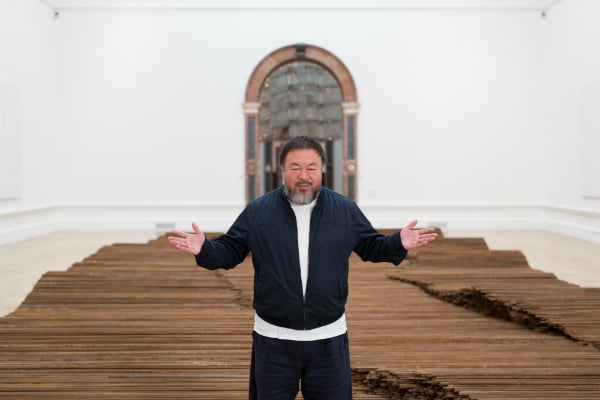
For most artists there are probably few things as frustrating as having to deal with a biography that eclipses their art production. And I don’t mean it in the self-mythologizing vein of Joseph Beuys, or the joyful pop banality of Andy Warhol, but in the “Ai Weiwei, China’s most prominent dissident artist” sense.
After several years in which Ai’s coverage has been mostly related to either updates on his troubling conflict with Chinese authorities (who kept his passport confiscated for over four years), his Instagram stunts, or the whooping prices his works fetch at auction, the earnest appreciation of his oeuvre by critics and commentators seemed to have well and truly taken a backseat.
Luckily, Ai’s fantastic survey at London’s Royal Academy—sure to become the mega-blockbuster exhibition of the city’s busiest art season—is finally bringing the focus back on where it should have remained: the quality of his work.
The hotly anticipated exhibition was already heaving with critics and VIPs days before its public opening on Saturday. But, despite the numbers, the mood in the gallery rooms was quiet and respectful, as if echoing the gravity of some of the artworks on display.
Installation view of Ai Weiwei’s Straight at London’s Royal Academy of Arts, 2015.
Photo: Lorena Muñoz-Alonso
Straight (2008-2012)—a massive installation made up of 90 tons of steel bars taken from the school buildings that collapsed during the 2008 Sichuan earthquake, leaving over 5,000 children dead—is a case in point. I had duly read about the piece (originally made with 200 tons of steel, far too heavy for the RA’s floors), but nothing could have prepared me for encountering it in the flesh.
Somber, eerie, and deeply moving, the piece is completed by two large wall panels, in which the names of the victims are spelt, and a recent video, in which Ai explains the making of the piece, which can be credited with sparking the frictions that landed him in detention a few years later. (While researching for the piece, Ai found that political corruption was behind the shoddy construction of the schools, which made them as a safe as a house of cards when the huge tremor hit).
Ai’s team worked painstakingly for years to straighten the tons of bars, which had been completely twisted and mangled in the catastrophe. The sheer scale of the enterprise does not only highlight the huge loss of life in terms of volume. It also comes across as a homage to the victims, and a portrait of a team striving to return things to their ideal form or shape, while being keenly aware of the impossibility, and even futility, of doing so.
Ai Weiwei taking a photograph of his installation Coloured Vases at London’s Royal Academy of Arts, 2015.
Photo: © Dave Parry Courtesy Royal Academy of Arts, London.
In other rooms, most of them organized around a taxonomy of materials and motifs (including ceramics, marble, furniture, and cubes), the exhibition curators distill Ai’s key artistic strategy, which can be synthetized as an astute blend of traditional Chinese craftsmanship with Western avant-garde tropes (the Duchampian readymade; the Dada pun; the humorous use of noble materials to convey banal objects).
And there are some tremendous smaller works in that vein, like a Han Dynasty vase with a Coca Cola sign emblazoned across it (Coca Cola Vase, 2014), a classic Ai motif which he has constantly come back to over the years and still works, like a joke that doesn’t lose its punch no matter how familiar it becomes. Or Hanging Man (1985), a human profile outlined with a pedestrian metal hanger, so simple and yet so beautiful.
Ai Weiwei’s Coca Cola Vase (2014).
Photo: Lorena Muñoz-Alonso
But if there’s anything that this shows makes clear, is that Ai is a true master of the monumental scale. Many contemporary artists have explored it (from Christo, Richard Serra, and Christian Boltanski to Antony Gormley and Anish Kapoor, to mention a few) with varying degrees of success, but Ai’s masterpieces can consistently be found when he goes big and epic, which is no mean feat.
Among the large-scale pieces included in this show, the one I found most convincing was S.A.C.R.E.D (2012), formed by six models (half the size) of the cell in which he was imprisoned for 81 days in 2011.
Installation view of Ai Weiwei’s S.A.C.R.E.D (2012) at London’s Royal Academy of Arts, 2015.
Photo: Lorena Muñoz-Alonso
Though small windows on the walls and on the roofs, accessible through little steps, viewers are invited to snoop and spy on what went inside, conveyed though minute and naturalistic dummies of Ai, his two guards, and the cell’s bleak interiors. We see Ai being interrogated, having a shower, eating, sleeping, and relieving himself, all of it while the two guards look on, every inch of dignity and privacy snatched away from him.
As I watched the groups of people queuing to look though the holes of S.A.C.R.E.D, I marveled at the tightrope act Ai is capable of achieving, at how the artworks in this exhibition respond to those challenging real events with such a poised balance between humor and poignancy, criticality and respect.
Detail of Ai Weiwei’s S.A.C.R.E.D (2012) at London’s Royal Academy of Arts, 2015.
Photo: Lorena Muñoz-Alonso
“Ai Weiwei” is on view at London’s Royal Academy of Arts from September 19-December 13, 2015.
Related stories:
Ai Weiwei and Anish Kapoor Call for Protest Walk for Refugees
Ai Weiwei and Anish Kapoor Joined by Activists in Protest March for Refugees